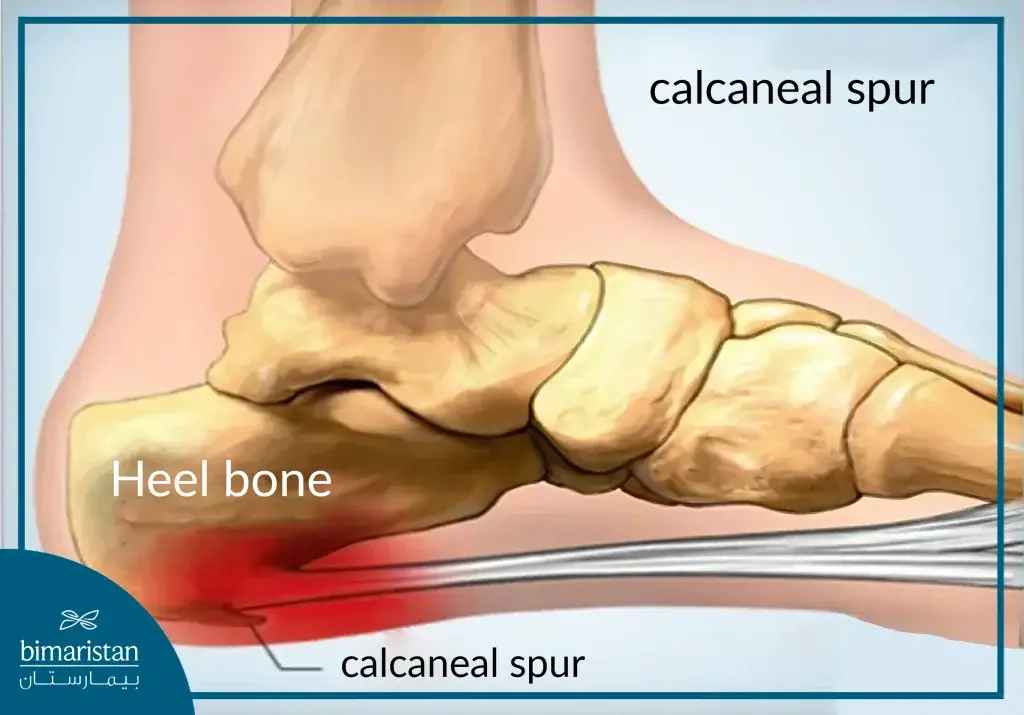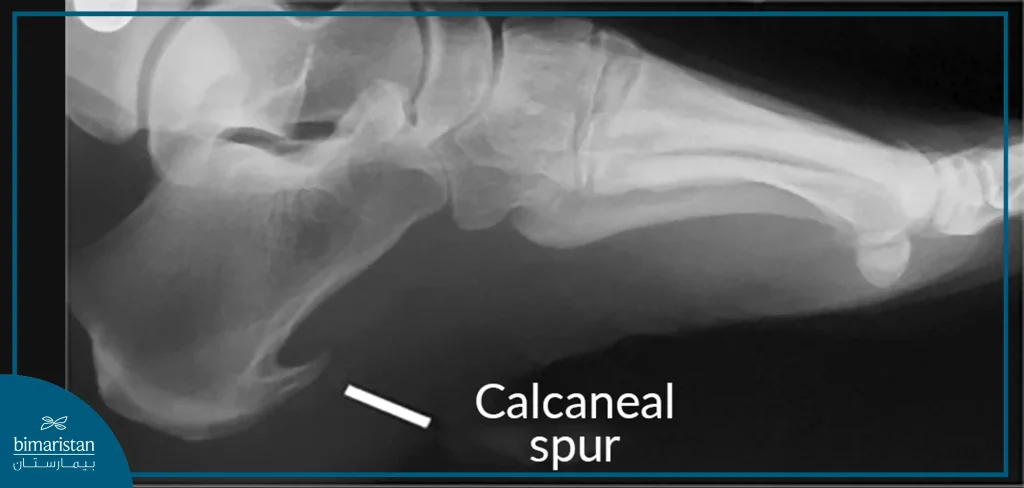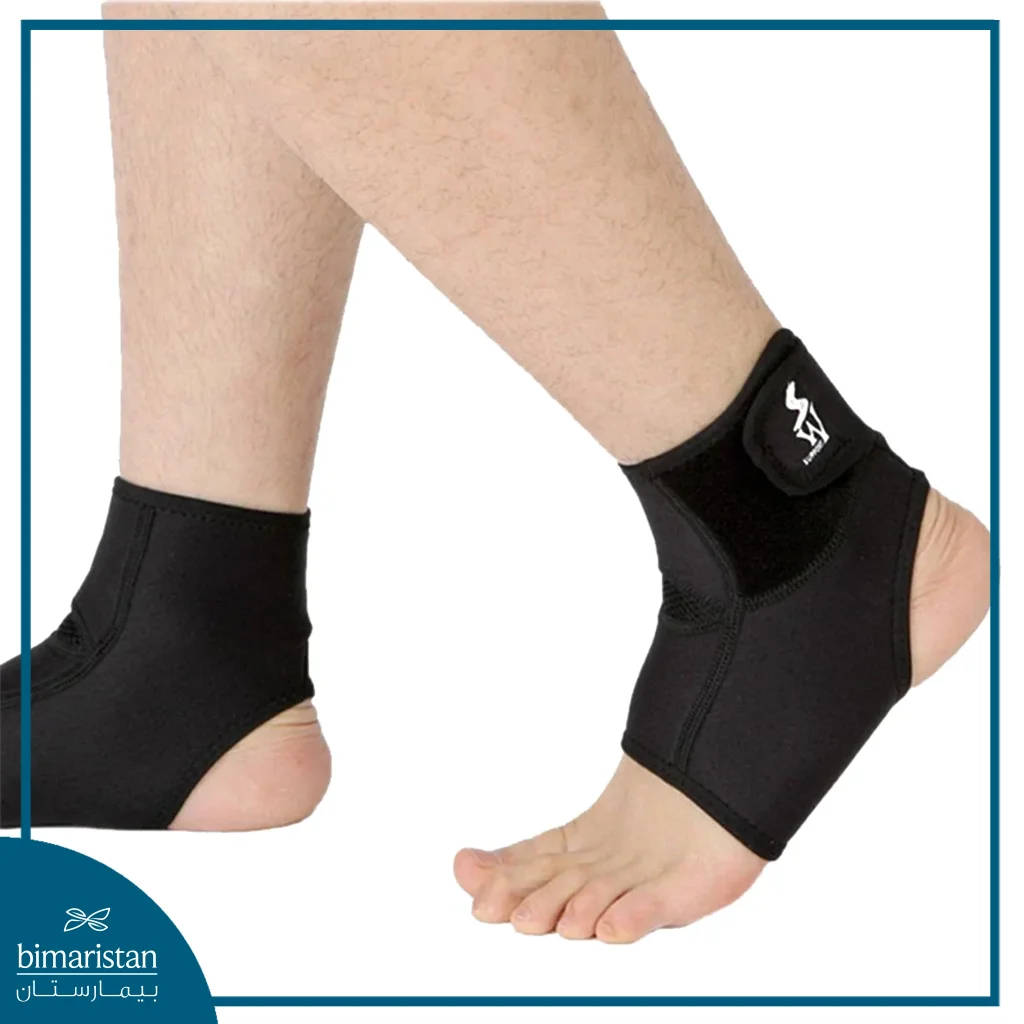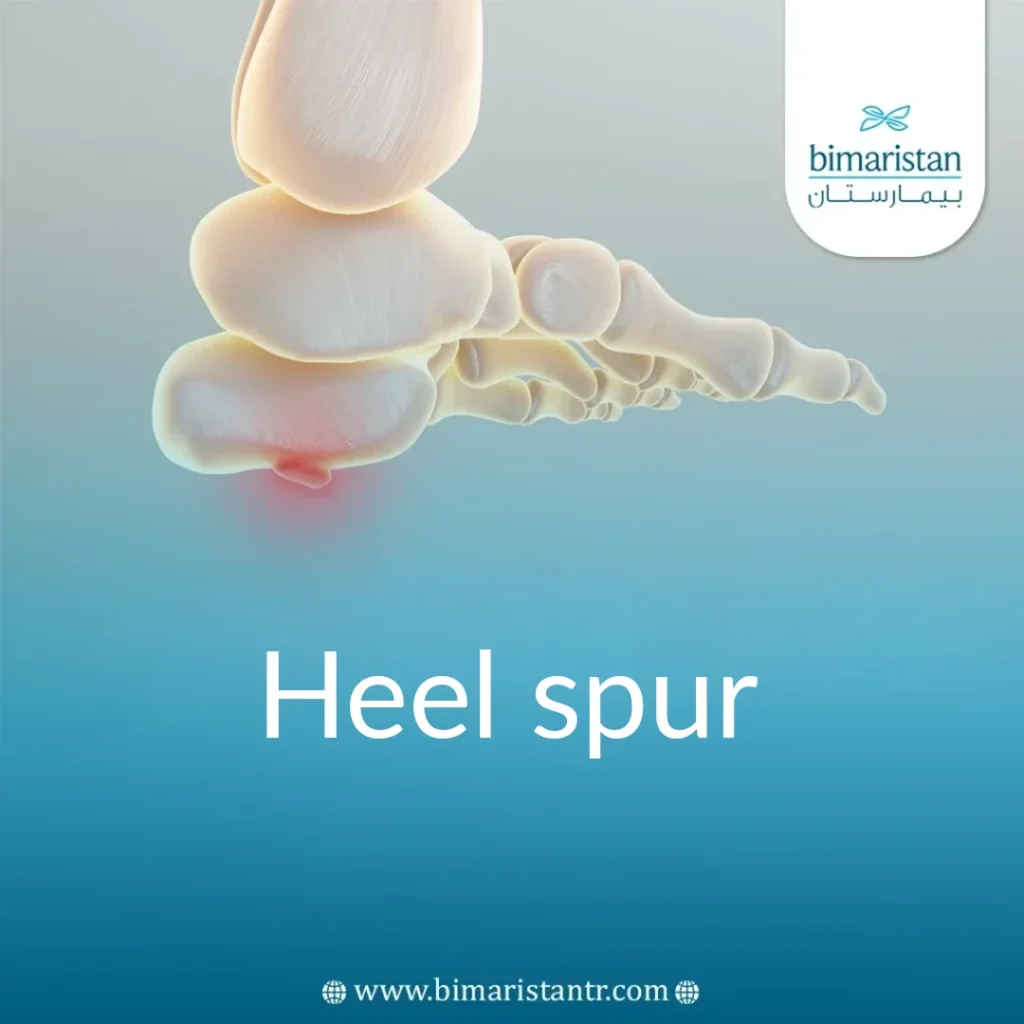A heel spur (calcaneal spur) is a common cause of pain in the bottom of the foot at the heel. A bone protrusion in the heel bone area causes inflammation and pain in the surrounding tissue.
What is a heel spur?
A heel spur is a bony development in the heel bone of the tarsal bone of the foot caused by excess calcium buildup due to local or systemic disease.
This protrusion causes irritation and inflammation of the surrounding structures, leading to pain in the bottom of the foot at the heel area, and may also cause redness and swelling in this area.

Heel spur symptoms
Most often, heel spurs are asymptomatic and do not cause pain to the patient. Because their length does not exceed 1.5 cm in the worst case. Heel spurs themselves do not cause pain, but depending on their location, they may cause damage to the surrounding tissues, and thus the following symptoms may appear:
- Persistent or intermittent pain in the bottom of the foot, especially while walking or running
- Severe pain in the foot during the first steps of the day after waking up (or after resting)
- The patient describes his pain as like a pin or nail in the bottom of the foot and spreads to the top of the heel at the ankle.
- Swelling and redness in the heel
Heel spur causes
There are many causes in the patient’s heel bone. These causes include local diseases in the foot and systemic diseases (general) that occur throughout the body. Knowing the cause of this medical condition is important in treatment.
One of the predisposing factors and causes of heel spurs is stress, one of the most important causes. Walking for long periods or running and jogging long distances are also risk factors. However, this process takes a long time, meaning that this stress must be on the patient’s heel for months to form bone spurs.
The patient’s plantar stress is exacerbated if he wears uncomfortable shoes that do not support the arch of his feet or if he walks on hard ground, which will lead to pain in the bottom of the foot in the heel area due to heel spurs.
Risk factors also include:
- Overweight
- Arthritis
- Foot trauma
- Plantar fasciitis
- Abnormal walking methods
- Idiopathic skeletal hyperostosis
- Flat feet or high arches
- Diabetes
How are heel spurs diagnosed?
Pain in the bottom of the foot occurs due to several different diseases, most notably plantar fasciitis and calcaneal spurs. To differentiate between them, the doctor will request an X-ray of the feet from the inner side of them.
In the image, we notice a bone spur at the bottom of the heel bone, which is excessive ossification and calcium accumulation due to inflammation and continuous damage to the heel bone. We may also notice a calcaneal spur on the upper surface of the calcaneus.
This bony protrusion is called a heel spur. If other medical conditions causing pain in the bottom of the foot are ruled out, the heel spur is the main culprit, and thus, the diagnosis is made.

If you suffer from pain in the bottom of your foot and cannot walk, especially with your first steps in the morning, contact us. We can help you identify the disease you suffer from and tell you how to treat it.
Prevention of heel spur
It can affect anyone, especially those whose daily lifestyle depends on standing for long hours, such as teachers, or walking long distances, such as marathon runners.
So if you have previously suffered from heel spurs and recovered, or you are now learning about them, you should protect yourself from getting them – because the pain will hinder your ability to walk – by following the following tips:
- Wear comfortable medical shoes that support the arch of the feet. Worn-out shoes that do not support the arch will cause bruises in the sole and bruises in it, and thus a painful corn will form in the heel, or the injury will also occur with inflammation of the plantar fascia due to a tear in it.
- If you suffer from pain in the bottom of the foot once, you should resort to rest immediately and not continue to do strenuous work on the bottom of the feet so that you do not develop heel spurs.
- Also, with rest, it is preferable to put ice on the painful area for a few minutes to reduce the swelling and inflammation in the heel because the formation of a heel spur in the bone is an inflammatory process resulting from repeated trauma to the sole, causing severe pain.
Heel spur treatment
Heel spur treatment is often done using traditional home treatment methods. When they are not useful, we resort to more advanced non-surgical methods. In the end, if all the previous methods are not useful, surgery is the final solution to treat heel spur.
Traditional treatment for heel spur
Traditional conservative treatment is often the most important in treating heel spur and is the key to recovery, whether we rely on it alone or combine it with other treatment options.
The most important conservative treatments at home that are medically recommended:
Rest
Rest is the most important advice in treating calcaneal spur and comes at the forefront of advice for effective treatment. Because continuous and intense effort will lead to a worsening of the condition and lack of healing in the bone even if we rely on other treatments.
Cold compresses (ice)
If you suffer from calcaneal spur pain and notice swelling and redness of the heel, it is recommended that you apply cold compresses to the painful area to reduce swelling, inflammation, and pain. Apply them several times a day for 15 minutes at a time.
Painkillers and anti-inflammatory medications
Since the calcaneal spur are an ossification that occurred as a result of an inflammatory process in the heel in addition to causing pain to the patient, the key to solving these two problems together is painkillers from the non-steroidal anti-inflammatory class such as ibuprofen.
Medical shoes
The patient should wear shoes that support the arch of the feet and are flexible and spongy and do not put pressure on the sole when walking on hard ground. It may be sufficient to add medical insoles to the regular shoe to solve the problem.
Non-surgical treatment for heel spurs
The doctor does not prefer to resort to a surgical solution quickly. This is because most patients improve with traditional treatment and non-surgical treatment. So if home treatment for calcaneal spur doesn’t work, we resort to the following options:
Steroid injection
Cortisone injections in the area of pain help relieve pain and reduce inflammation, swelling, and redness, thus improving heel spur symptoms. However, this treatment option should not be relied upon repeatedly due to its side effects if you get used to it.
Physiotherapy in Turkey
This physical therapy for heel spurs is performed under the supervision of doctors specializing in physical therapy. They recommend some exercises that suit your condition to relieve calcaneal spur pain
Some of these exercises include the following:
- Stretching the hamstring muscle while leaning on the wall.
- Stretching the hamstring muscle with the foot placed on a higher level than the other foot
- Rolling a tennis ball on the ground using the sole of the foot
Other well-studied exercises suit your condition, as it does not matter what the exercise is, but the number of times it is done per day and the time required to do it at one time, and this varies depending on your condition.
Contact us—we are the Bimaristan Medical Center—if your condition is chronic and requires surgery to return your foot to normal. We will guide you to the correct treatment methods for heel spurs and provide you with support to reach the best healthcare in Turkey.
Foot braces
For some people, wearing a foot brace may help reduce the friction of the bone spur in the heel with the surrounding tissues, thus reducing tissue inflammation and pain resulting from that friction with the calcaneal spur.

Surgical treatment of heel spurs in Turkey
90% of patients improve with conventional and non-surgical treatment. However, 10% of patients do not benefit from these treatments. Therefore, surgery is indicated if the patient suffers from heel spur symptoms for six months or a year despite resorting to the treatments above.
The surgical procedure for treating heel spurs involves making a surgical incision in the foot to remove the bone spur.
Surgical treatment may also include releasing the plantar fascia by separating the connection between it and the heel (calcaneus bone) because the pain may be caused by plantar fasciitis and the presence of heel spurs is asymptomatic or contributes with fasciitis to the symptoms.
When heel spurs cause severe pain, the patient’s life becomes difficult due to the inability to walk. The patient should not neglect his condition so that it does not deteriorate. Relying on conventional treatments at home is sufficient in most recovery cases.
Sources:



